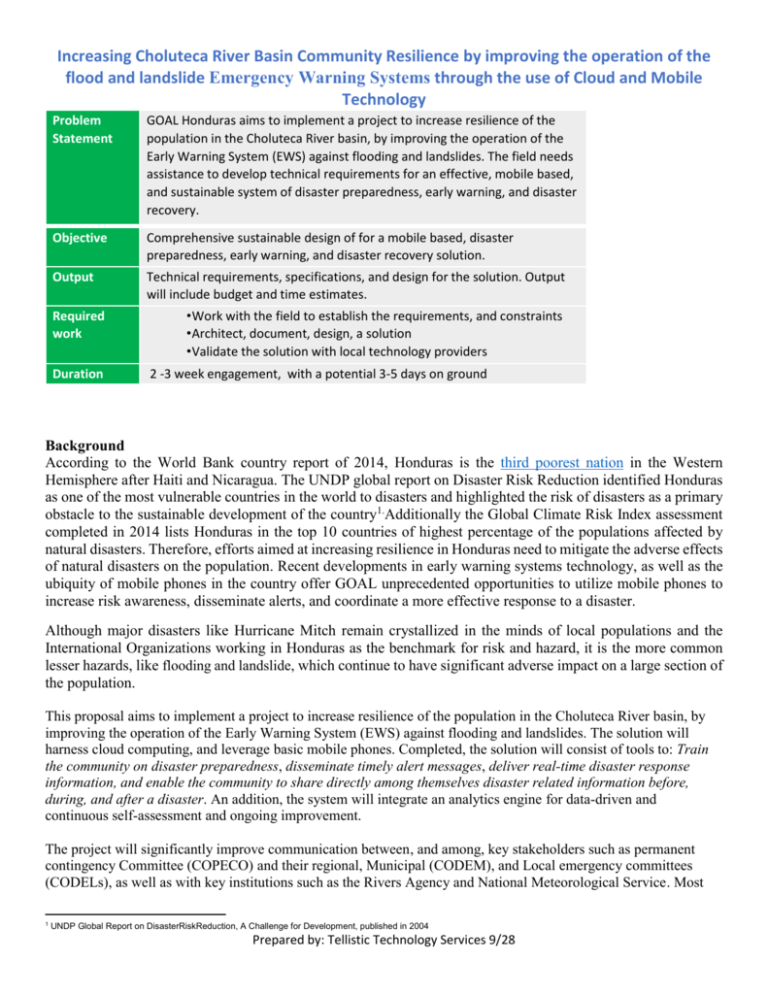Increasing Choluteca River Basin Community Resilience by
advertisement

Increasing Choluteca River Basin Community Resilience by improving the operation of the flood and landslide Emergency Warning Systems through the use of Cloud and Mobile Technology Problem Statement GOAL Honduras aims to implement a project to increase resilience of the population in the Choluteca River basin, by improving the operation of the Early Warning System (EWS) against flooding and landslides. The field needs assistance to develop technical requirements for an effective, mobile based, and sustainable system of disaster preparedness, early warning, and disaster recovery. Objective Comprehensive sustainable design of for a mobile based, disaster preparedness, early warning, and disaster recovery solution. Output Technical requirements, specifications, and design for the solution. Output will include budget and time estimates. Required work Duration • Work with the field to establish the requirements, and constraints • Architect, document, design, a solution • Validate the solution with local technology providers 2 -3 week engagement, with a potential 3-5 days on ground Background According to the World Bank country report of 2014, Honduras is the third poorest nation in the Western Hemisphere after Haiti and Nicaragua. The UNDP global report on Disaster Risk Reduction identified Honduras as one of the most vulnerable countries in the world to disasters and highlighted the risk of disasters as a primary obstacle to the sustainable development of the country1.Additionally the Global Climate Risk Index assessment completed in 2014 lists Honduras in the top 10 countries of highest percentage of the populations affected by natural disasters. Therefore, efforts aimed at increasing resilience in Honduras need to mitigate the adverse effects of natural disasters on the population. Recent developments in early warning systems technology, as well as the ubiquity of mobile phones in the country offer GOAL unprecedented opportunities to utilize mobile phones to increase risk awareness, disseminate alerts, and coordinate a more effective response to a disaster. Although major disasters like Hurricane Mitch remain crystallized in the minds of local populations and the International Organizations working in Honduras as the benchmark for risk and hazard, it is the more common lesser hazards, like flooding and landslide, which continue to have significant adverse impact on a large section of the population. This proposal aims to implement a project to increase resilience of the population in the Choluteca River basin, by improving the operation of the Early Warning System (EWS) against flooding and landslides. The solution will harness cloud computing, and leverage basic mobile phones. Completed, the solution will consist of tools to: Train the community on disaster preparedness, disseminate timely alert messages, deliver real-time disaster response information, and enable the community to share directly among themselves disaster related information before, during, and after a disaster. An addition, the system will integrate an analytics engine for data-driven and continuous self-assessment and ongoing improvement. The project will significantly improve communication between, and among, key stakeholders such as permanent contingency Committee (COPECO) and their regional, Municipal (CODEM), and Local emergency committees (CODELs), as well as with key institutions such as the Rivers Agency and National Meteorological Service. Most 1 UNDP Global Report on DisasterRiskReduction, A Challenge for Development, published in 2004 Prepared by: Tellistic Technology Services 9/28 Increasing Choluteca River Basin Community Resilience by improving the operation of the flood and landslide Emergency Warning Systems through the use of Cloud and Mobile Technology significantly, however, the system will empower the community to actively participate and prepare for, respond to, and recover from a disaster. The technical aspects of this project will consist of the following key features: Cloud Based: To continue operation of the system from anywhere, and minimize risk of shutdown due to local disaster impact. Enhanced USSD: To reduce dependency on the internet, and the cost of SMS, to deliver critical messages Community Chat: To allow the population to generate warning alerts, and to forward incoming ones (eg from Local Emergency Committee to evacuation brigades) Mobile device independent: Solution should run on any mobile device, including non-internet enabled feature phones, and finally Improving Operation of critical monitoring equipment: By sending alert messages to administrators of the EWS on the operation of river gauges and rain gauges (23 stations in total throughout the catchment) ensuring continuous operation of this equipment. Market Based Sustainability: Solution should have built-in market based approaches for sustainability. See Diag #1 below. Proposed project location and impact Initial implementation will be in the Choluteca River basin. Choluteca River is one of the longest in the country and covers an area of 7,560 Km2 of which 34 Km2 are directly affected by the river. The river crosses 80 communities in 21 of the 46 municipalities which make up the basin, including some parts of the capital city Tegucigalpa. Within that catchment, the city of Tegucigalpa is severely affected by landslide risk with an estimated 50,000 families in landslide prone areas. The number of persons who would be impacted by the project exceeds 1.5 million. If successful, the solution would be scaled up to the rest of the country, and potentially other parts of Latin America and the Caribbean. External Dependencies: 1) Partnership agreement with a Telco operator to deploy the enhanced USSD platform 2) Local developers / ISVs willing to implement market solutions on the USSD platform for sustainability 3) Telco Zero rating EWS service 4) Training content on emergence preparedness, and recovery after an emergency Diag.#1 Prepared by: Tellistic Technology Services 9/28 Increasing Choluteca River Basin Community Resilience by improving the operation of the flood and landslide Emergency Warning Systems through the use of Cloud and Mobile Technology Prepared by: Tellistic Technology Services 9/28







